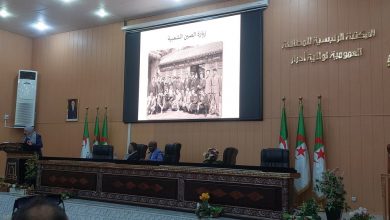Algiers – A group of skilled women artisans in Algiers have been working tirelessly for decades to revive and safeguard Algiers-style embroidery, a rich cultural heritage that is increasingly under threat from piracy and the proliferation of digital embroidery techniques.
Sitting in front of her traditional “qarqaf” embroidery frame, Khalida Tahraoui works meticulously on a piece of white fabric adorned with intricate floral patterns. “This is Algiers-style embroidery,” she says proudly, referring to the distinctive motifs and stitches that define this type of craftsmanship.
Tahraoui explained that she is currently recreating an antique piece from the 17th century that she saw at the National Museum of Popular Arts and Traditions in Khdaouj El Amia Palace in Algiers’ Casbah district. She has chosen to replicate the original colors used at that time—mainly red and dark blue—and hopes the new piece will be faithful to the original design.
Despite being less well-known among younger generations in Algeria, this embroidery style has earned international recognition under its original name, associated with Algiers. Tahraoui pointed to photos on Pinterest showcasing examples of Algiers-style embroidery and mentioned that one such piece is even preserved at Harvard University’s museum.
Tahraoui learned the art of embroidery during the 1990s at the Belouizdad School of Industrial and Decorative Arts. Recalling her early years, she explained how she began her training at 16 years old, mastering basic techniques before advancing to more complex methods, such as needle painting, Richelieu embroidery, cross-stitching, and finally, Algiers-style embroidery.
Today, Tahraoui works as a teacher at the same school, now transformed into a center for embroidery, sewing, and other artistic crafts such as silk painting and culinary arts. She is committed to inspiring women and young girls to embrace this traditional art, hoping to attract more students in the coming academic year to preserve the heritage.
Her friend and former colleague, Naima Bougabrin, shares her passion. Even after retiring seven years ago, Bougabrin remains committed to teaching the craft. She still keeps an old embroidery book from the 1970s, which contains a full chapter dedicated to Algiers-style embroidery.
Bougabrin recalled learning the art from a teacher who, in turn, had acquired the craft from an elderly woman in Algiers during the 1950s. At that time, her teacher worked with the woman at a girls’ orphanage in Bouzareah, passing down the tradition to the next generation.
Key Stitches of Algiers-Style Embroidery
Bougabrin described some of the distinctive stitches used in Algiers embroidery, such as the “Zlilj” stitch, often combined with the “Lmrouba” and “Manzel” stitches, or the quilted “Matelassé” technique. Other stitches include the “Mallaqa” (also known as “Tajer” stitch), as well as “Khatt,” “Modhfoura,” and “Richa” stitches, which are secondary stitches typically used alongside the primary ones.
Both artisans emphasized that they are part of a small community of embroiderers still practicing this endangered art. They expressed hope that younger generations will take up the craft, calling for more training initiatives to prevent the tradition from falling into oblivion.
Tahraoui warned of the piracy of Algiers embroidery patterns and techniques, explaining that designs exclusive to Algeria are sometimes misappropriated by neighboring countries and presented in foreign media as their own heritage. She expressed her dream of seeing Algiers-style embroidery and other traditional Algerian crafts listed on UNESCO’s World Heritage List.
Sustaining Craftsmanship Amid Market Challenges
To preserve and promote the art, the artisans suggested creating dedicated spaces to exhibit traditional embroidery, particularly during regional and international events. They cited the 2022 Arab League Summit in Algiers, where a handicraft exhibition at the Palais des Rais (Bastion 23) received high praise from diplomats impressed by Algeria’s rich artistic and cultural diversity.
The artisans believe that educational workshops and public exhibitions are crucial tools to prevent piracy and preserve the craft in the face of growing competition from digital embroidery. Such initiatives also provide financial stability for artisans by enabling them to market their products to both local and international tourists.
Their views are shared by Faiza Riach, director of the Palais des Rais, who emphasized the role of Algerian museums in reviving and transmitting traditional arts. Riach announced plans to launch educational workshops in November, which will be housed in a dedicated section of the palace called “Dar El-San’aa”. The workshops will teach various crafts, including Algiers-style embroidery, glass painting, wood carving, leatherwork, and traditional weaving.
Riach also highlighted the importance of academic research in preserving these crafts, arguing that formal documentation is essential. “Although Algeria shares certain cultural elements with other Maghreb and Mediterranean countries, it has unique features that must be protected. Academic research is key to archiving and preserving these distinctions,” she said.
In addition to Algiers embroidery, Riach mentioned other intricate techniques, such as the “Chebika” style, along with the famous “Mejboud” and “Fetla” embroidery, which use fine gold and silver threads on velvet fabrics. These techniques, she noted, will also be revived through the upcoming workshops, ensuring that Algeria’s traditional crafts continue to thrive.
For more cultural news and updates, visit DZWATCH.DZ.
Author: nor-eleslam
Algiers Embroidery, Traditional Crafts, Heritage Preservation, Cultural Identity


